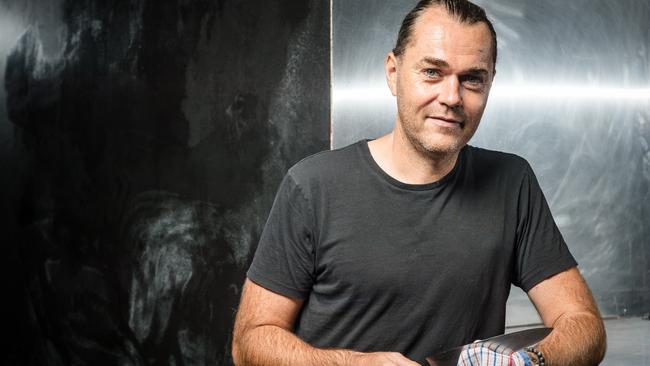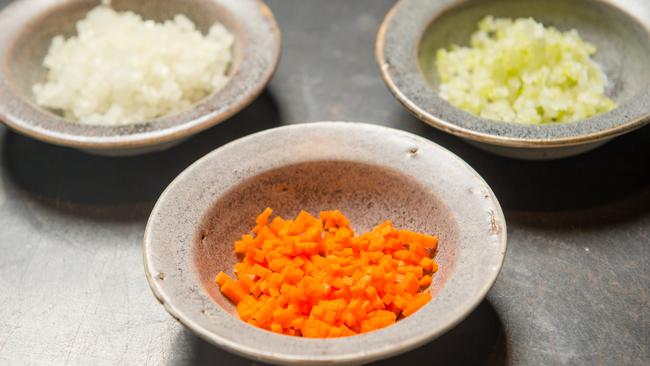Vue de monde’s Shannon Bennett reveals the essential kitchen skills he expects from apprentices
THINK you’ve got the basic of cooking covered? Here’s what Vue de monde’s Shannon Bennett expects his apprentices to master and how to hone your own skills at home.

Eating Out
Don't miss out on the headlines from Eating Out. Followed categories will be added to My News.
HE might be the head of a restaurant empire that spans cafés and casual eatery through bakery and bar to the highest echelons of fine dining, but like all chefs Shannon Bennett started at the bottom of the kitchen ladder.
The 15-year-old apprentice was the first in the kitchen in the morning at Max’s at the Hyatt – at the time Melbourne’s most prestigious restaurant — and often the last to leave.
“I had to come in two hours earlier than every other chef, just so I would have all my prep done in time,” the now 42-year-old chef says. “I was so slow at the start, all these things were so foreign to me. But all I wanted to do was to succeed, to learn the skills that are used in all the Michelin-starred restaurants in Europe.”
Among the many skills he perfected during his apprenticeship at Max’s, Shannon learnt how to cut a classic brunoise – a fine dice of vegetables that are used to flavour sauces and soups, how to make the perfect hollandaise sauce and how to cook the perfect omelette.
MORE FOOD NEWS:
THIS VIC RESTAURANT IS ONE OF WORLD’S BEST
THE DISH THAT’LL MAKE YOU VISIT MUSE
HIDDEN FOODIE GEMS IN OUR INDUSTRIAL HEARTLAND

“You go in at that age, so enthused. I’d read all the books, watched TV shows, you think you know so much, but the first day in the kitchen, you realise you know nothing.”
The Vue Group founder and creative director says the pressure on young apprentices today is even greater than when he first donned chef’s whites.
“I think there’s more pressure on young chefs to learn less skills and to qualify (as a chef) quicker. There’s more exposure to food, the internet means you can do more learning outside of the kitchen now,” he says. “But things like a classic brunoise, or how to shuck an oyster or how to make the perfect omlete are being lost.”
The Vue Group runs its own four-year apprenticeship program, where two chefs in each year work across the group, with the final six months being spent in the kitchen at the flagship Vue de monde (ranked number 4 in the delicious. 100).
Shannon then encourages his newly-qualified chefs to head overseas to cement their skills and gain experience and perspective.

“I’m a bit old fashioned but I think it’s important for the chefs to go and do 12 months in a 3 Michelin-star restaurant. Once you have that under your belt you can do anything, run a catering company, a pastry shop. You’ve seen every aspect of the industry.”
And while Shannon says a brunoise isn’t the type of skill a home cook needs (“I’d never chop an onion like this at home!”) being confident with using a sharp knife is key to kitchen success.
“I think every home chef should learn how to fillet a fish, how to truss a chicken and how to make the perfect crackling,” he says. “Another good trick, I actually teach the (MasterChef) contestants this now, is to use a toothpick to devein prawns. Through the back of the prawn, put the toothpick through the tract widthwise and lift it out, it will come out. I learnt that at Max’s.”
Reckon you could pass Shannon’s apprentice skills test? Here’s how.

CLASSIC BRUNOISE
“We use the brunoise as an assessment for apprentices, spread out the vegetables to make sure the dice is uniform, see if any pieces are uneven,” Shannon says.
A classic French technique, brunoise is a fine 3mm dice of vegetables, traditionally carrot, onion and celery. The vegetables are then quickly blanched in salted water and used to garnish soups and used in sauces.
For onion brunoise, quarter and then peel the petals out. Dice each petal separately.
“It’s laborious, but it will give you the finest dice. These are the skills I think you go out to a restaurant for.”
For carrot brunoise, cut into rectangle by topping, tailing and squaring the sides. Cut the carrot into 5cm long pieces, then cut into 3mm slices. Stack these and cut into sticks 3mm wide. Then slowly cut into dice.
And for celery, Shannon says this is the showstopper for non-chefs. “People don’t know how you get it looking so good.” The key is to first peel the celery, which will get rid of any stringiness.


Cut into 5cm long pieces, slice lengthways into strips 3mm thick, then matchstick and dice.
“Don’t do this while socialising for two reasons,” Shannon says. “Firstly, your fingers will go missing and two, it will take you four hours to cut them all up!”
As for what you might use a brunoise at home for – apart from bragging rights – Shannon says it’s great for a garnish for a delicate broth or soup, or as a ratatouille-like filling for stuffed zucchini or stuffed zucchini flower.
“Take a broth, pop some Lombok underneath a piece of steamed fish. Brunoise veg, scattered on top – all of a sudden you have a restaurant dish at home.”


CLASSIC HOLLANDAISE
While you can use melted butter to make a hollandaise, Shannon says using clarified butter will give you the rich nutty flavour that French chefs seek of this classic sauce.
You can use a microwave for this – 500g of butter will give about 300ml clarified butter (microwave on high for 2 mins in a glass jug, or until melted, let stand and spoon off the top foamy layer), which will make sauce for eight serves. They don’t say butter is the French chef’s best friend for nothing.
Infusing white wine/champagne vinegar with peppercorns, bay leaf and parsley stalks and reducing it by half will also add delicate perfume to the sauce.

Whisk four egg yolks over a water bath, vigorously whisking the vinegar when the yolks come up to temperature. “You’re looking for a really thick foam that you can make a ‘H’ with the whisk, then you’re ready to add the clarified butter,” Shannon says.

Add the butter in gradually, whisking to combine. If the hollandaise becomes too thick before all the butter has been added, loosen the mix with a few drops of warm water.
When all the butter has emulsified, season with salt at the end.
“You could serve this with some steamed fish, steamed potatoes and spinach, and you have the perfect supper,” Shannon says.

FRENCH OMELETTE
“Nowadays, if you ask five chefs how to make the perfect omelette you get five different answers, but the classic way we were taught, the French way, was that it should have no colour, and be so delicate and light you can eat it with a spoon,” Shannon says.
The key is to use the freshest eggs you can source, and cook them slowly in a pan on medium heat.

Lightly whisk four eggs, and add to a non-stick pan with a pinch of salt and a knob of butter that’s gently bubbling. Stir the eggs as you would scrambled eggs, which stops them colouring. After a couple of minutes as the eggs are cooking, stop stirring to let the omelette form.

RELATED FOOD NEWS:
BENNETT‘S $40M PLANS FOR HISTORIC SITE
SHANNON’S BENNY BURGER OPENS IN RICHMOND
CHEF HITS BACK AT UNDERPAY CLAIMS
Once the top of the omelette is almost set but still wobbly, add a filling down the centre – grated cheese; finely chopped herbs, or leave as is – then, tip the pan slightly to roll the omelte down the pan.
“The classic omelette is shaped like a cigar that’s nice and soft and delicate in the centre,” Shannon says.
“In the Carlton Vue de monde days when I started, I used to do a omelette with a little fennel salad. It got me through the first six months – low food cost, high skills that people appreciated. It was on the lunch menu with some smoked cod. Just lovely.”


WATCH THIS: Shannon sets an apprentice skills test immunity pin challenge on MasterChef tonight at 7.30pm on TEN



